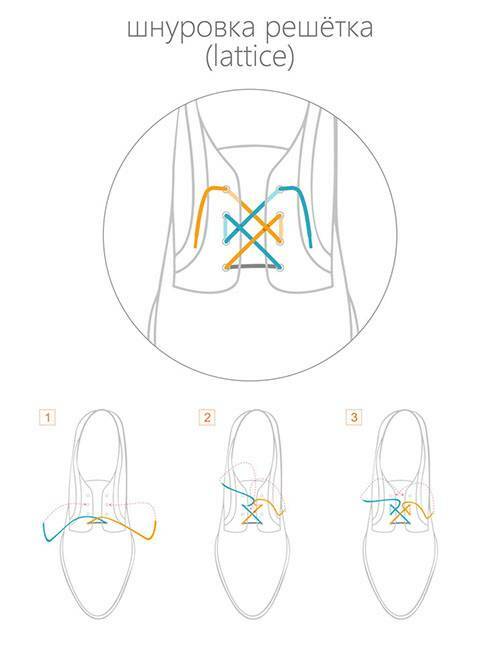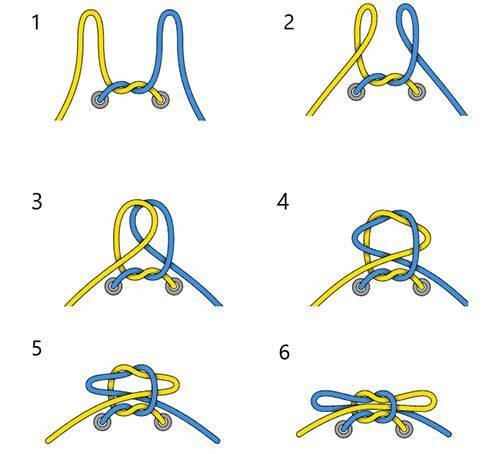Buying lace-up shoes, we rarely make changes to the vision of the designer and do not think about the type of lacing on sneakers or oxfords you can change at your discretion. Laziness or just a lack of intriguing options deprives you of the opportunity to make shoes look fresh, fresh, and we are ready to correct this omission!

Top functional and decorative lacing
You will not believe that some craftsmen crank with laces: sometimes shoes with extravagant and nontrivial lacing are more drawn to contemporary art than some exhibits in the galleries. But this does not mean that a simpler weave can not surprise you, because, as statistics show, in all our shoes in 99% of cases only one type of lacing is used.

- Cross type
This type has almost completely mastered the market and is used for lacing everything from classic men's shoes to sports shoes and even skates. Why did this happen? It's hard to say, because there are other equally simple ways to tie your shoes. But to do this cross-wise in modern mass production for some reason is simply accepted, which means that we will also consider this type the default option.
But even in such a basic model, you can slightly rejuvenate: you can decide whether you will pass the shoelaces from the purse or from the front.
So, pull the cord through the holes at the very bottom so that both sides have the same length, then pass each end alternately through the opposite hole above, observing the type of passing( purl or facial).
The advice of
It is important to follow the order: the chaotic interlacing does not look very nice, so decide which end will be below and which one will cover it, and repeat the same or mirror lacing on the other shoe. Also, the alternation of the upper and lower ends will be an interesting move: the one that was on top will go back the next time and vice versa, creating a spiral effect.

- Straight
This lacing is so laconic and elegant that it will certainly fall in love with all connoisseurs of classic footwear, because it is on it that her charms reveal themselves in full force. Let it not be created as quickly and easily as a cross, and tightening the laces will take a little longer in the morning, but its aristocratic chic is worth it.
Pull the cord through the holes at the bottom on the front side so that the shoelaces on both sides are approximately the same length. Now each end you need to pass into the hole above: left to the next, and right through one. Opposite to each end there are free eyelets, which now need to pass the cord from the front side so that they form two parallel lines. So you need to tie up the shoes to the very top.
advice Direct lacing is infrequently used on sneakers and sneakers because of small inconveniences with tightening the laces, but if sports shoes are intended to be used not for sports but for everyday wearing, even on it you can make lacing in this way.

- Diagonal
This lacing, although not the most common, looks fresh both on classic shoes and on sneakers, especially in the mirrored version - it remains to understand how to properly implement the process of its creation.
To begin with, the shoe must be threaded through the lower holes so that on one side it comes in from inside and on the other from the outside. The ends on both sides must be of the same length. The end that comes from inside, now you need to pass through the hole opposite, but this time from the front side. And vice versa, the end that was passed from outside, now passes through the hole opposite from the wrong side. Further, lacing continues along this scheme to the upper holes.
Board
If you are looking for a method for lacing skates, then it's better to opt out of beauty in favor of functionality. Laces on skates need to be tightened quite strongly, especially in the area of lifting the leg, to ensure proper fixation, providing stability and safe riding. The bottom and top of the lacing on the skates can be tied not so tight: from the bottom it is unlikely to work, and from the top, tightening can provoke a violation of the blood supply to the foot.

- Military lacing
We do not know how much military lacing looks beautiful on sneakers, sneakers and classic shoes, but on turtles and boots it is very appropriate to apply such a weave if you know how to tie it correctly.
Again stretch the lace of the front side so that both laces are about the same length. Overlapping them, thread the tips into the next opposite holes from the wrong side. Now, both ends are threaded into the next holes in your own row so that the laces come out from inside. It remains to repeat the operation until both shoes are laced up.

- Lattice
Looking for something original, beautiful and catchy eye? Then try to repeat the grate on your favorite pair of shoes. On sneakers and sneakers, this method seems to be the most advantageous, but it can be refreshed and classics if we carefully make the weaving. And although mastering this method of lacing will not be as easy and quick as a cross, a little effort is worth the result that you will see.
Pull the string through the lower eyelets so that the ends come out from the front and are more or less the same length. Overlap the ends and thread each on the front side into the opposite upper hole, but not the next in the row, but through one. Now each end should take a step back in its series: stretch both ends into the bottom free hole. Now a cross-maneuver and a step back should be repeated again.
Advice
The best way would be to look at boots with 6 eyelets in each row, although 4 is the minimum amount.

Technical side of the question
Lace up shoes or shoes a little: you need to tie up the shoelaces as well. If you think that you are doing it right, then you should try one of these ways on yourself. Are ready to argue that you can tie the laces very quickly and so that they are untied only when you need it!

- Two loops
After the initial knot, twist the ends of the shoelace in opposite directions, creating loops, grasp each of the loops with the opposite hand and pull one through the other, tightly tying the knot. After a short practice of shoelaces you can tie in less than a couple of seconds!

- Surgeon's unit
To prevent the laces from loosening, use serious knots when lacing. To master this lacing is not so easy, and even with the time to meet in 2 seconds is unlikely to work, but the bow on the laces will remain tightly tightened as much as you need it. It is best to understand how such a knot is tied, following the steps on the diagram.

- Double sliding node
If you are still looking for a reliable node that you can tie more quickly, then learn how to make such a node. Having created two loops, cross them, bend the ends of the loops in opposite directions, pass through the bottom and tighten in the desired direction. After a little practice, you will cross, traverse and tighten in no time!
There is more than one way to tie shoelaces on shoes, and although this knowledge will not change your life dramatically, it can make a difference in your image, and also save time on tying shoelaces!


